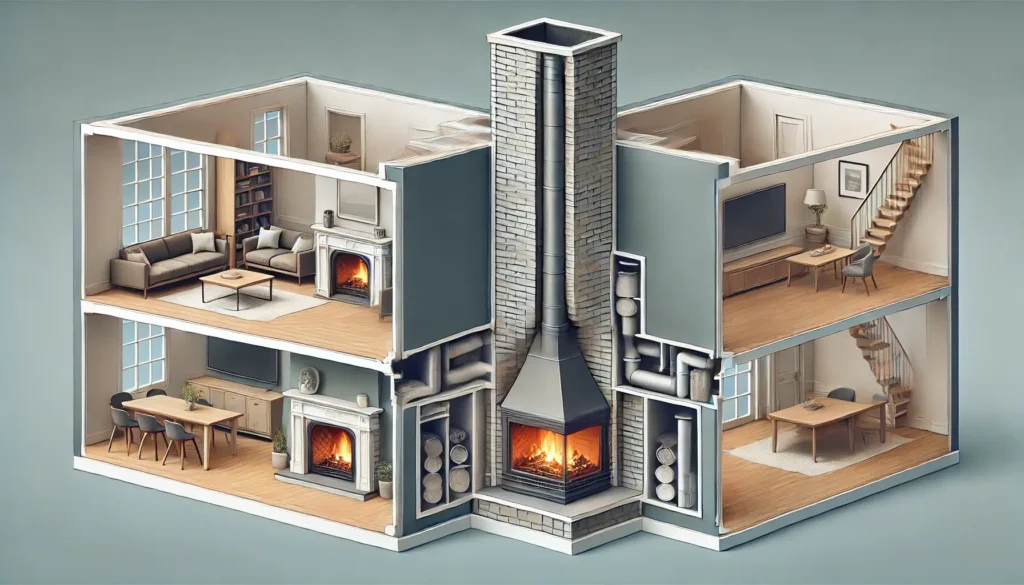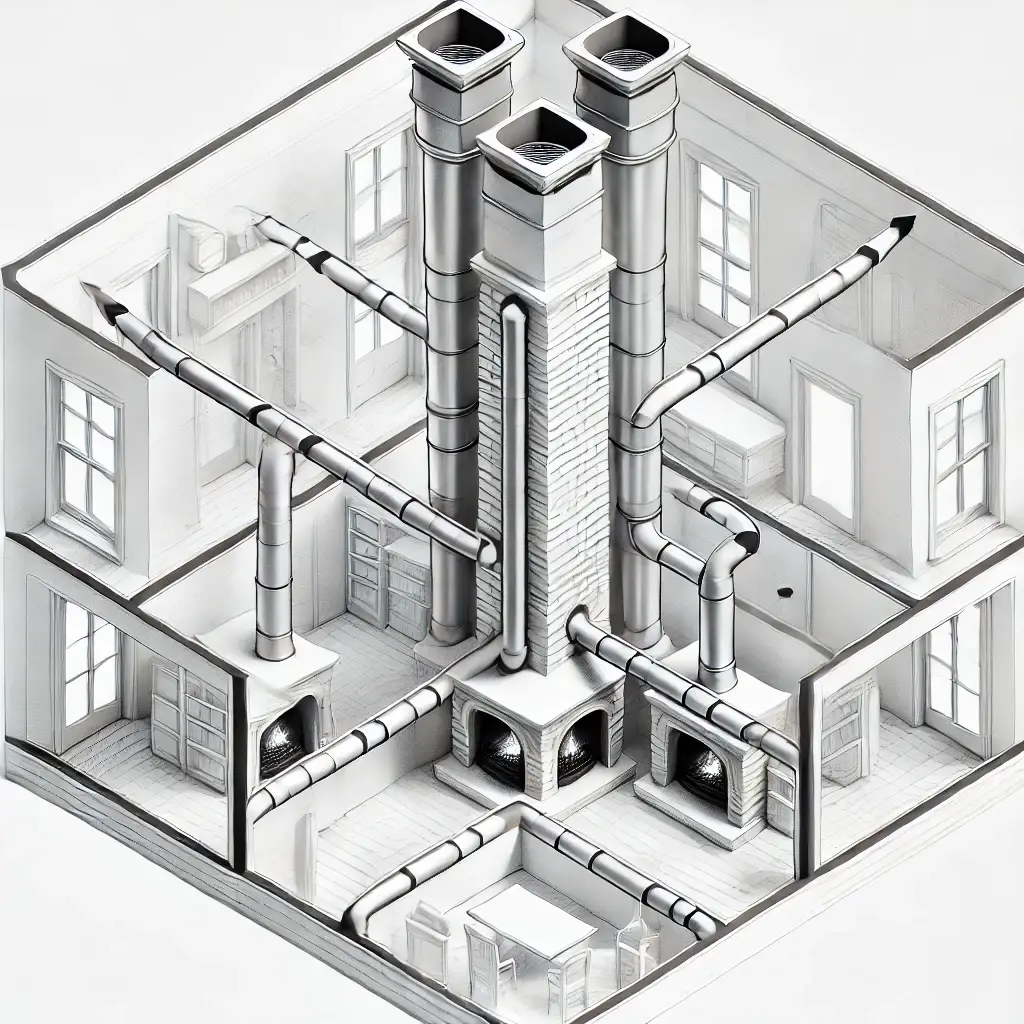Thinking about installing two fireplaces in your home but wondering if you can use the same chimney? It’s a common question, especially for homeowners looking to save on installation costs or maximize heating efficiency. While it’s possible to install two fireplaces on one chimney, there are several technical, legal, and safety factors you need to consider.
Yes, it is possible to install two fireplaces on one chimney, but there are important considerations to ensure safety and functionality. Each fireplace must have its own chimney flue (liner) to minimize the risk of chimney fires and allow for independent operation.
In this article, we’ll explore how it works, its pros and cons, and whether it’s the right solution for your home.
Chimney and Fireplace Structure
Before diving into whether two fireplaces can share a chimney, it’s important to understand how chimneys and fireplaces work together.
What Is a Chimney Flue?
A chimney flue is the passage inside a chimney that allows smoke, gases, and other byproducts of combustion to exit your home safely. Each fireplace requires a properly functioning flue to ensure proper venting.
Types of Chimneys
There are two primary types of chimneys used in homes:
- Masonry Chimney: Built from bricks or stones and often used in traditional homes.
- Prefabricated Chimney: A factory-made system that is easier to install and less expensive.
Each type of chimney has specific guidelines when it comes to sharing flues.
Can you Install Two Fireplaces on one chimney?
Yes, it is possible to install two fireplaces on one chimney, but there are important considerations to ensure safety and functionality. Each fireplace must have its own chimney flue (liner) to minimize the risk of chimney fires and allow for independent operation.
The chimney needs to be designed to accommodate multiple flues, as conventional chimneys intended for a single fireplace may not safely vent smoke and gases from two fireplaces simultaneously. If the fireplaces are located on different floors, the chimney must extend from the lowest floor up to the roof, with proper clearance between adjacent flues.
It is also essential that both fireplaces burn the same type of fuel either both wood-burning or both gas to prevent complications related to varying emissions and venting needs.

Key Considerations for Installing Two Fireplaces on One Chimney
- Separate Flues Required:
- Each fireplace must have its own chimney flue (liner). This is crucial to minimize the risk of chimney fires and to allow for the independent operation of each fireplace, even if they use different types of fuel.
- Chimney Design:
- The chimney must be designed to accommodate multiple flues. Conventional chimneys intended for a single fireplace may not safely vent smoke and gases from two fireplaces simultaneously. However, chimneys designed with multiple flues can effectively manage this.
- Structural Requirements:
- If the fireplaces are on different floors, the chimney must extend from the lowest floor up to the roof. Proper clearance between adjacent flues is also essential; for example, an 8-inch masonry wythe is recommended between flues.
- Fuel Compatibility:
- If both fireplaces are to share a single flue, they must burn the same type of fuel (e.g., both wood-burning or both gas) to ensure safe operation. Mixing different types of fireplaces can lead to complications due to varying emissions and venting needs.
- Fireplace Placement
- The placement of the two fireplaces also matters. Are they on the same floor or different levels of your home? If they’re on different levels, it’s critical to configure the flue system correctly to prevent airflow issues.
- Same-Level Fireplaces: Easier to manage with separate flues.
- Different-Level Fireplaces: Require precise flue management to avoid backdraft risks.
- The placement of the two fireplaces also matters. Are they on the same floor or different levels of your home? If they’re on different levels, it’s critical to configure the flue system correctly to prevent airflow issues.
- Local Building Codes:
- Always consult local building codes and regulations before proceeding with installation. Compliance with safety standards is critical for preventing hazards associated with chimney fires and smoke backflow.
- Professional Consultation:
- It is advisable to work with a qualified professional who can assess your specific situation, provide guidance on design, and ensure that all installations meet safety codes.

Pros and Cons
Pros
- Using one chimney for multiple fireplaces saves space compared to having separate chimneys.
- Reduces the need for additional chimney construction costs.
- Can enhance the visual appeal of a home by offering multiple fireplace options.
Cons
- One of the biggest risks is backdraft, where smoke and gases from one fireplace can flow into the other. This can lead to carbon monoxide buildup, which is a serious safety hazard.
- More frequent maintenance may be required due to multiple flues.
- If not properly configured, smoke could enter the living space through unused flues1.
Is It Legal to Install Two Fireplaces on One Chimney?
According to the NFPA, fireplaces on different levels of a home should not share a flue unless special conditions are met. It’s crucial to consult a professional chimney inspector or your local building authority to ensure compliance.
Many building codes regulate whether two fireplaces can share a chimney. The National Fire Protection Association (NFPA) provides guidelines for this, but local codes may vary. In some areas, sharing a chimney is allowed as long as there are separate flues.
How Two Fireplaces Can Share a Chimney
There are two primary ways two fireplaces can share a chimney:
- Separate Flues for Each Fireplace: The safest and most common approach.
- Single Flue with Dampers and Adjustments: A more complex setup that requires precision to avoid smoke backdraft issues.
Technical Requirements
- The chimney must be properly sized to handle the venting needs of both fireplaces.
- Proper dampers and ventilation mechanisms must be in place to prevent backdraft.
- Regular maintenance is essential to avoid flue blockages and safety hazards.
Alternatives
1. Installing Two Separate Chimneys
Although it’s more expensive, having separate chimneys for each fireplace is the safest and most efficient option. This eliminates any risks associated with shared chimneys.
2. Dual-Sided Fireplace
A dual-sided or see-through fireplace can serve two rooms with one chimney. These fireplaces are popular in open-concept spaces and provide a modern, luxurious feel.
3. Modern Ventless Fireplaces
Ventless fireplaces are another option. They don’t require a chimney or flue, making them easier to install and maintain. However, they do need proper ventilation in the room to ensure safety.
Costs of Installing Two Fireplaces on One Chimney
| Expense | Estimated Cost |
|---|---|
| Chimney Inspection | $100 – $500 |
| Chimney Modifications | $1,500 – $3,000 |
| Fireplace Installation | $2,000 – $5,000 per unit |
| Flue Adjustments | $500 – $2,000 |
| Maintenance Costs | $200 – $400 annually |
Safety Tips
1. Schedule Regular Inspections and Cleaning
A shared chimney requires more frequent inspections to check for blockages, creosote buildup, and structural issues. Hire a professional chimney sweep at least once a year.
2. Install Carbon Monoxide Detectors
Since the risk of backdraft and carbon monoxide buildup is higher with shared chimneys, installing carbon monoxide detectors is essential. Place them near the fireplaces and sleeping areas.
3. Ensure Proper Ventilation
Make sure your flue system is correctly adjusted, and that each fireplace has adequate ventilation to prevent smoke and gas spillage.
Final Thoughts
So, is it a good idea to install two fireplaces on one chimney? It depends on your home’s structure, budget, and safety priorities.
- Who It’s Best Suited For: Homeowners with large chimneys and the ability to have separate flues.
- Who Should Avoid It: Those with small chimneys or who can’t afford regular maintenance.
If safety is your top concern, it may be better to install separate chimneys or opt for a modern ventless fireplace.
FAQs
Can two fireplaces share the same flue?
In most cases, it’s not recommended for two fireplaces to share the same flue. Separate flues are safer and help prevent issues like backdraft and smoke spillage.
How often should a shared chimney be cleaned?
A shared chimney should be cleaned at least once a year. If you use your fireplaces frequently, consider cleaning it every six months to prevent creosote buildup.
Are there alternatives to using a shared chimney?
Yes! Alternatives include installing separate chimneys, using a dual-sided fireplace, or opting for ventless fireplaces, which don’t require a chimney at all.
Is a dual-sided fireplace more efficient?
Yes, dual-sided fireplaces are more efficient as they can heat two rooms simultaneously using one chimney. They also provide a sleek, modern design element.
What is the most cost-effective way to heat multiple rooms with fireplaces?
The most cost-effective way is to use a dual-sided fireplace or ventless fireplaces. These options reduce installation costs and ongoing maintenance expenses.
Affiliate Disclosure: Fireplaceadviser.com is a participant in the Amazon Services LLC Associates Program. We may earn a commission when you click on certain links on this site and purchase.

Hello!! I am Jamal Khan. I often fix my home electric heaters and gas stove problems and research the common issues in the heating units to improve my knowledge and expertise. The aim of establishing fireplaceadviser.com is to share my expertise and knowledge with my audience.












